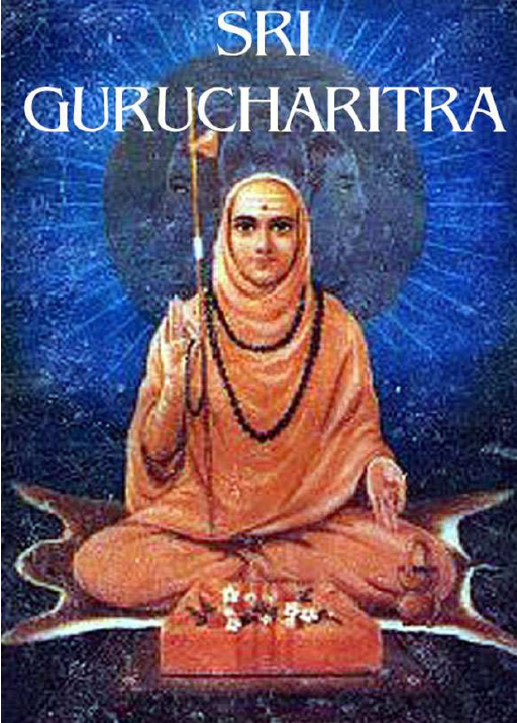Sri Guru Charitra is an ancient sacred scripture based on the life story of Sri Narasimha Saraswati (1378-1459), written in Ovi form (a Marathi metre) by the 15th-16th century poet Sri Saraswati Gangadhar. His ancestor, Sayamdev, had personally lived and served Guru Narasimha Saraswati. The book was later translated into Sanskrit by Sri Vasudevananda Saraswati (Tembe Swami), who lived about a hundred years ago and was regarded by many as an incarnation of Lord Dattatreya. Until a few years back, the book was only available in Marathi and Kannada languages. Recently, Telugu translations have become available, as well as an English version. The English version is a newly rendered and abridged version of the original Guru Charitra.
Aside from the life stories of the first two Avatars of Lord Dattatreya, Sripada Srivallabha and Sri Narasimha Saraswati, the book also contains their spiritual philosophy and relevant life stories that illustrate how they delivered the truths of Sanatana Dharma through each and every one of their words and actions.
The book is written in a conversational form between Naamdharak and his Guru, Sri Siddha Muni, a disciple of Sri Narasimha Saraswati who consistently allays the doubts of his disciples by sharing various examples and stories from the lives of the first two Datta Avatars. The work is divided into three parts: Dhyankand (Knowledge section), Karmakand (Work section) and Bhaktikand (Devotion section).
Prior to 2001, when the biography of Sripada Srivallabha, the Sripada Srivallabha Charitamrutam, came to light, the Guru Charitra was the only source of information about the first incarnation of Lord Dattatreya

Even at the moment of his birth, He uttered the mystic syllable ‘Om’, and by the mere touch of His hand, he transmuted iron into gold. Even before he learnt the alphabet, he taught the Vedas to his disciples and expounded the Vedanta to his parents in his childhood. Even at that young age, he visited the holy places of pilgrimage, practiced yoga and restored the tradition of renunciation to its pristine purity through his own practice. He cured the intestinal illness of his devotee by making him partake of the very food which is prohibited to such by medical science. He transformed a tongue-less man into an elegant expounder of wisdom. He terminated the poverty of a Brahmin by his mere blessing, and he enabled him to visit three holy places in the wink of the eye.
– Chapter I
He revived the dead and made a barren cow yield milk. He conferred the vision of His cosmic form on his devotee, Trivikrama and humbled the pride of the learned. He made a devotee of low caste recite the Veda by his mere blessing. He terminated the widowhood of a lady and expounded the subtleties of karma yoga to a devotee. He made a withered twig grow into a tree and blessed a barren woman with offspring by his mere look. He cured one of leprosy.
– Chapter I
It may be possible to count the stars in the sky, the grains of sand on earth and the drops of water in the ocean, but not the infinite divine attributes of the Lord. Though He is a spirit without any form, he miraculously assumes a form and enters His devotee’s hearts through the gateway of his hearing and cleans his heart and liberates him in this very life from Ignorance.
– Chapter XI
Guru Charitra Paperback by Shree Swami Samarth Vishwa Kalyan Kendra
Sterling Publications; UK edition (Aug. 7, 2008)
© MyDattatreya 2021 All rights reserved
Designed by Tamara Lj.